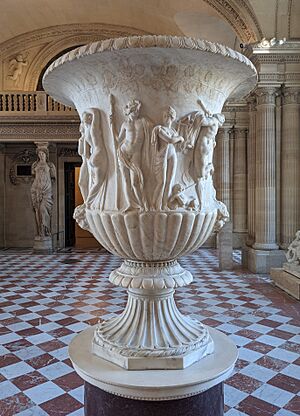Borghese Vase facts for kids
The Borghese Vase is a monumental bell-shaped krater (a large mixing bowl) sculpted in Athens, Greece, from Pentelic marble. It was made in the second half of the 1st century BC as a beautiful garden ornament for the Roman market. Today, you can see this famous vase in the Louvre Museum in Paris.

Contents
About the Vase
What it Looks Like
The Borghese Vase is very tall, standing about 1.72 meters (over 5 and a half feet) high. It is also wide, with a diameter of 1.35 meters (about 4 and a half feet). The vase has a deep band around it with carvings in bas-relief (sculptures that stick out slightly from the surface).
Its top edge is flared and decorated with a pattern called "gadroons," which look like rounded, parallel ridges. The bottom part also has this gadroon pattern. It used to have loop handles, but these are now gone. The vase stands on a wide, fluted (grooved) base, which has a rope-like design around its bottom. This all rests on a low, eight-sided stand.
The Carved Story
The carvings on the vase show a scene called the thiasus. This was an exciting procession that honored Dionysus, the Greek god of wine and celebration. In the carvings, Dionysus is shown wearing a panther skin and playing a musical instrument called an aulos (a type of flute). He is joined by Ariadne, a princess from Greek myths.
The other figures in the procession are often thought to be satyrs. Satyrs are mythical creatures that are part human and part goat or horse. However, the figures on this vase do not have the typical goat feet or horse tails. Some experts believe these figures are actually sileni, who are older, wise companions of Dionysus.
There are also draped figures. While some might think they are Maenads (female followers of Dionysus), these figures are actually male. One figure is shown being anointed, which is a special act often linked to gods. This has led some to believe that the scene might show Apollo and Dionysus helping Silenus, who appears to be falling.
History of the Vase
How it Was Found
The Borghese Vase was found in 1566 in a Roman garden. This garden was part of the ancient gardens of Sallust in Rome. After its discovery, the powerful Borghese family bought the vase.
Later, in 1808, Napoleon bought the vase from his brother-in-law, Camillo Filippo Ludovico Borghese. Since 1811, the Borghese Vase has been proudly displayed in the Louvre Museum in Paris, where millions of people can admire it.
Artistic Inspiration
The French artist Hubert Robert was very inspired by the Borghese Vase. He painted it in several of his artworks. In one painting, he made the vase look even bigger and placed it on the Aventine Hill overlooking the Colosseum. This was a dramatic artistic choice, as the vase was never actually there. Robert also painted the vase in other settings, including the famous gardens of Versailles.
Famous Copies
The Borghese Vase is one of the most famous and copied ancient marble vases. It was often paired with the slightly smaller Medici Vase to create a balanced look. Its style was loved by artists during the Baroque and Neoclassical periods.
Many copies of the Borghese Vase were made:
- Three pairs of copies were created for the Bassin de Latone (Latona Fountain) in the beautiful gardens of Versailles in France.
- Pairs made of alabaster (a soft, white stone) can be found in the Great Hall at Houghton Hall in Norfolk, England.
- Bronze copies are at Osterley Park in Middlesex, England.
Smaller versions of the vase were also popular. They were sometimes used as wine coolers, made from silver or silver-gilt. For example, Paul Storr made silver-gilt copies for the Prince Regent in 1808. The artist John Flaxman even based a carved relief on the vase's frieze, which is now in Sir John Soane's Museum in London.
Throughout the 18th and 19th centuries, the Borghese Vase continued to be copied. It was reproduced in materials like bronze and porcelain. For instance, a smaller copy made of Coade stone (a type of artificial stone) from 1770-1771 is at the Temple of Flora at Stourhead. Josiah Wedgwood, a famous potter, also made versions of the vase in his jasper ware around 1790. He even added a lid and a Neoclassical pedestal to his copies.
Images for kids
-
Capriccio: draughtsman sketching the Borghese Vase, red chalk, Hubert Robert, c. 1775



